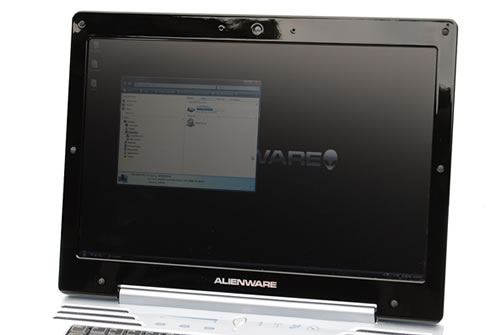Standard and optional configurations
The Alienware Area-51 m15x is special in the sense that it is the first and currently the only product to support the GeForce 8800M GTX graphics card and Intel Core 2 Extreme X9000 processor in a 15.4-inch notebook.
Due to the obvious thermal issues involved when pairing such high-end hardware together, no other manufacturer has attempted to pull this one off in such a confined space.
Our test system featured Intel's flagship mobile CPU, the new 45nm Core 2 Extreme X9000 processor, which operates at 2.8GHz, 6MB Cache and 800MHz FSB. However, there are cheaper options to choose from. After all, the Core 2 Extreme X9000 costs an additional $900 over the base processor which is a Core 2 Duo T8100 processor operating at 2.1GHz with a 3MB Cache.
For just $150 it is possible to upgrade this to a Core 2 Duo T8300 processor that works at 2.4GHz. Other options include the Core 2 Duo T9300 at 2.5GHz for $250, or the Core 2 Duo T9500 at 2.6GHz for $525.
Perhaps the next if not the most important component in a gaming laptop is the GPU. The most expensive (and best performing option) is the Nvidia GeForce 8800M GTX 512MB graphics card which sets you back ~$500. However, for $350 less it is possible to downgrade to the 8700M GT, while the base model is the 8600M GT, which is the typical GPU offered on powerful yet non-gaming oriented desktop replacement laptops.

The default memory configuration is two DDR2-667 512MB modules, for a total of just 1GB. For gaming we wouldn't recommend anything below 2GB, which will cost $150 extra, while 4GB of memory will cost an incredible $350 more. As mentioned before, for an additional $50 there is also the option to include the Intel Turbo Memory (1GB) card for those running Windows Vista.
There are a myriad of possible storage configuration on the Area-51 m15x, from the base 120GB SATA hard drive that spins at 7200RPM, all the way up to a 500GB drive that gets slowed down to 5400RPM. The largest drive that spins at 7200RPM weighs in at 320GB, featuring a 16MB cache and an extra $275 price tag. There is also a SSD option available, which basically means you get the works as far as configuration goes, no other manufacturer gives you these many options.
Those that wish to include a second removable drive can do so using the Smart Bay feature. There are five possible capacities to choose from a 120GB drive ($150) up to a 500GB ($400) hard drive.
It should be noted however that the Smart Bay comes loaded by default by an 8x dual layer burner in the base configuration. You can upgrade this to a LightScribe drive for a small fee, or exchange it for a dual layer Blu-ray disc reader for $300, or a 2x dual layer Blu-ray burner for $400 extra.
On board there is a 7.1/5.1 digital high-definition integrated audio solution that drives two internal speakers, which were surprisingly good when compared to the average notebook speakers. Still, most gamers are probably going to plug a powerful set of headphones into the Area-51 m15x. That being the case, if the integrated audio does not cut it for you, then spending another $100 on an external Creative X-Fi Xtreme audio card might be the go.
The AlienFX Illuminated keyboard, which we have to say looks very cool, is unfortunately an optional extra for which gamers are required to fork out another $50 (still not too bad).
The standard 15.4" LCD supports a 1440x900 resolution (720p) which may be the best way to go if you want to keep things sane about Windows font settings and overall usage outside gaming. For an extra $150 you can get the higher res panel that provides a native WideUXGA 1920x1200 resolution (1200p) as featured on our review sample.
Notable accessories that you can buy as extras include the HDMI to DVI-D adapter for those wanting to use DVI ($20), and a secondary Smart Bay 6-cell battery that will cost $150.